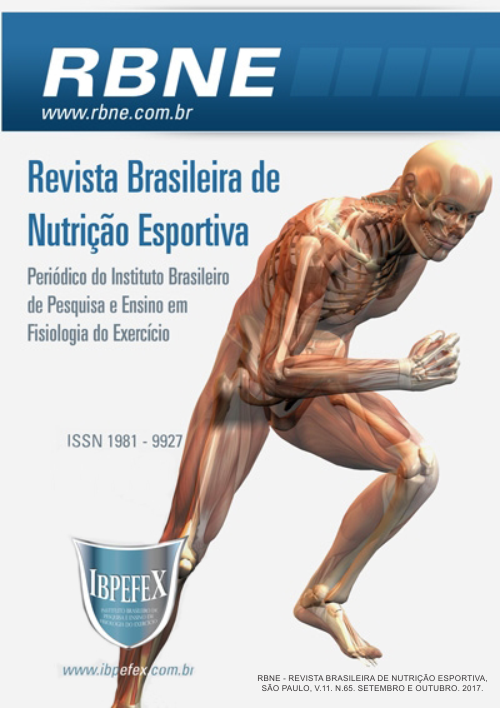Nutritional composition of diets detoxification disclosed in magazines and digital media not scientific
Abstract
Introduction: Detox diets are popular diet strategies that aim to facilitate the elimination of toxins and weight loss. Objective: To analyze the nutritional composition of detoxification diets disclosed in digital media unscientific. Materials and Methods: We conducted a cross sectional study of descriptive documentary and descriptive nature of detoxification diets selected in non-scientific media. The nutritional composition of the diet was calculated by Table of Food Composition (Tucunduva) and compared with the recommendation proposed by the DRIS (Dietary Reference Intakes) for macronutrients and micronutrients. For the calculation of diets, they were adopted as standard recommendations for adults with age range 19-50 years. Discussion: According to Klein and Kiat (2014) Currently, there are no scientific studies that have investigated the effectiveness of commercial detox diets to lose weight. Results: Regarding macronutrient diets, 61.5% of the menus had adequate protein, 23% had sufficient amount of carbohydrates and 38.4% contained adequate amounts of lipids. With regard to micronutrients, 15.3% of the menus in relation to the fibers are suitable; none of the menus was analyzed appropriate with respect to iron and calcium. Conclusion: Most diets published in scientific journals has no inadequacies in the distribution of macronutrients and micronutrients, which can compromise the nutritional status of individuals. These data reinforce the importance of diets are individualized and accompanied by a qualified professional, a nutritionist.
References
-Fiore, E. G.; Campos, V. J.; Mattos, L. L.; Pelliciari, M. C.; Nuzzo, L. Perfil de Indivíduos com Diferentes Níveis de Sobrepeso e Avaliação do Consumo Alimentar Frente às Diretrizes do Guia Alimentar para a População Brasileira. Revista Nutrição em Pauta. Num. 87. p. 11-16. 2007.
-Gargallo,F.M.; Basulto, M.J.; Breton, L.I.; Quiles, I.; Formiguera, S.X.; Salas-Salvadó, J. Evidence-based nutritional recommendations for the prevention and treatment of overweight and obesity in adults (FESNAD-SEEDO consensus document). Methodology and executive summary (I/III).NutrHosp. Madrid. Vol. 27. Num. 3. p. 789-799. 2012.
-Guerra, A. J. P. G.; Calainho, C. S. Emagrecer sem benefícios, ACrevista Júnior de Investigação. Vol. 1. Num. 1. p. 61-64. 2012.
-Klein, A. V.; Kiat, H. Detox dietas para a eliminação de toxinas e controle de peso: uma revisão crítica da evidência. J Nutr Hum Diet. 2014. doi: 10.1111/jhn.12286.
-Lima, K.V.G.; Bion, F.M.; Lima, C.R.; Nascimento, E.; Albuquerque, C.G.; Chagas, M.H.C. Valor nutricional de dietas veiculadas em Revistas não científicas. Rev. Bras. Promoc. Saude. Vol. 23. Num. 4.p.349-357. 2010.
-Mahan, K.; Escott, S. Krause: alimentos, nutrição e dietoterapia. São Paulo. Roca. 2010.
-Santana, H. M. M.; Mayer, M. D. B.; Camargo, K. G. Avaliação da adequação nutricional das dietas para emagrecimento veiculadas pela internet. ConScientiae Saúde. Num. 2. p. 99-104. 2003.
-Peluzio,M. C. G.; Leite,J. I. A. Lipídes. In: Teixeira F No. Nutrição clínica. Rio de Janeiro: Guanabara Gookan; 2003. p. 18.
-Sequeira, O. C. M. Determinantes do consumo alimentar em adolescentes da Escola Secundária de Águas Santas. Dissertação de Mestrado em Ciências do Consumo Alimentar. Porto. Revista Científica do ITPAC. Vol. 7. Num. 1. Pub. 2. 2014. XII, 84 p. Acesso em 03/07/15. Disponível em: http://hdl.handle.net/10400.2/ /1802
-TACO. Tabela Brasileira de Composição de Alimentos. 4ª edição. revisada e ampliada. Campinas. UNICAMP. 2011.
-Philipi, S. T. Tabela de Composição de Alimentos: Suporte para Decisão Nutricional. Metha. São Paulo. 2003.
-Umbelino, D. C.; Rossi, E. Deficiência de Ferro: Consequências Biológicas e Propostas de prevenção. Revista de Ciência Farmacêutica Básica. Vol. 27. Num. 2. 2006. Disponível em:< http://www.fcfar.unesp.br/revista_pdfs> Acesso em: 17/10/2015
Authors who publish in this journal agree to the following terms:
- Authors retain the copyright and grant the journal the right of first publication, with work simultaneously licensed under the Creative Commons Attribution License BY-NC which allows the sharing of the work with acknowledgment of the authorship of the work and initial publication in this journal.
- Authors are authorized to enter into additional contracts separately for non-exclusive distribution of the version of the work published in this journal (eg, publishing in institutional repository or book chapter), with acknowledgment of authorship and initial publication in this journal.
- Authors are allowed and encouraged to post and distribute their work online (eg, in institutional repositories or on their personal page) at any point before or during the editorial process, as this can bring about productive change as well as increase impact and impact. citation of published work (See The Effect of Free Access).






